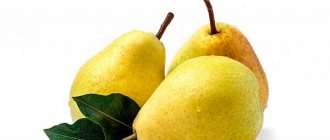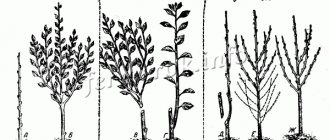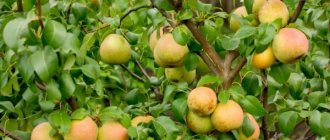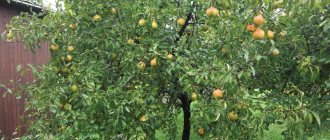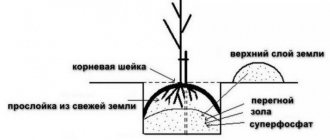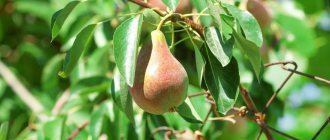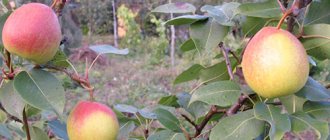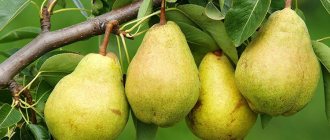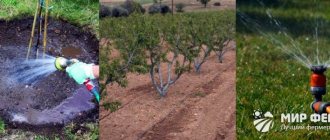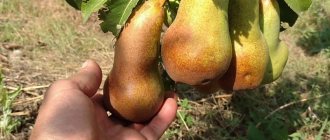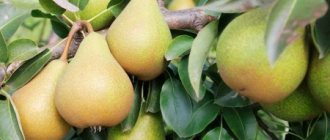Description of the variety
The late autumn variety Pamyat Zhegalov was created at the Moscow Agricultural Academy through the efforts of S. T. Chizhov and S. P. Potapov, who used the Lesnaya Krasavitsa and Olga pear varieties when crossing. This pear received its name in honor of the outstanding Soviet geneticist Sergei Ivanovich Zhegalov, who was the creator of the country's first specialized breeding department. In 1990, the variety was sent for State testing, and later the pear was zoned in the Central region, where it became most widespread .
Tree
The pear of this variety grows of medium height, but sometimes tall plants are also found. The bark on the trunk is gray or dark gray. The crown of a young pear has a funnel-shaped shape, but by the time of regular fruiting it takes on the usual oval or round shape. It consists of skeletal branches that grow almost vertically, and the top is not particularly dense. Rather, it can be called rare. The crown reaches its largest size quite quickly. The bark of the skeletal branches is light green.
Most pear shoots are directed upward, while the top of the crown is sparse
The shoots are brown, slightly curved, with medium internodes. Cone-shaped buds appear on them very early with a slight deviation from the branch. Lentils are small in size and convex. Zhegalov's memory does not have a high level of shoot formation.
The dark green leaves are medium in size and thickness and have an elongated round or oval shape. There is a slight curve along the central vein. The leaf blade is smooth, elastic and leathery to the touch without edges on both sides. The edges of the leaves are serrated. Petioles of medium length.
The inflorescences form a so-called raceme, containing 5–7 flowers. The medium-sized flower is cup-shaped and has white petals that are tightly closed. The bud is also white.
Fruit
The fruit of the Pamyat Zhegalov pear has an average weight of 120–130 g. It is covered with a thin, smooth skin with a slight gloss and some oiliness. Its main color is yellow-green; by the time of full maturity it acquires a barely visible reddish tint. There is minimal rustiness.
The fruits of the Pamyat Zhegalov pear are not the largest, but they have an excellent taste and aroma
The pulp is white or light yellow and very juicy. Tender, medium-grained, inside each fruit there are from 5 to 10 medium-sized seeds. The taste is refreshing and tonic, sweet with a slight sour accent. In combination with the pleasant aroma of the fruit, this gives rise to the most pleasant taste sensations. The peduncle is medium in length and thickness.
Appearance on a five-point scale is rated at 4.3 points.
Table: content of chemicals in fruits
| Compound | Quantity |
| Sahara | 9,3% |
| Acids | 0,41% |
| Soluble substances | 14,2% |
| Solids | 16,5% |
| P-active substances | 211 mg/ 100 g |
Advantages and disadvantages
One of the main advantages of the Pamyat Zhegalov pear is its early fruiting: the first harvest is harvested already 3–4 years after planting. In this it is similar to such autumn varieties as Oktyabrskaya and Noyabrskaya. By comparison, the same Dobryanka or Moscow Bergamot delights with fruits for the first time in 4–5 years, and February Souvenir even in 5–6 years.
The Pamyat Zhegalov variety is rated as productive, since under favorable conditions you can get about 40 kg of pears from one tree. This indicator is comparable to that of the Oktyabrskaya variety, and it is higher than that of the Noyabrskaya or Lyubimitsa Yakovleva varieties.
The fruits are well transported and can be stored for 100–120 days, which means that you can enjoy the fresh aromatic pulp until the end of January - beginning of February. Fruit shedding is weak, this allows you to save a significant part of the harvest.
Another advantage of the Pamyat Zhegalov pear is its excellent winter hardiness (like Yakovlev’s Lyubimitsa and Moscow Bergamot) combined with resistance to extreme weather conditions.
This variety perfectly resists the main fungal diseases of fruit trees, in particular scab.
A relative disadvantage can be called self-sterility. Pollinators must be selected carefully; the best varieties are considered to be Bergamot Moscow and Lyubimitsa Yakovleva . Chizhovskaya and Cathedral are considered quite good.
For the best pollination, suitable weather conditions are needed, under which there will be a mass emergence of bees and other pollinators.
Photo gallery: the best pollinating varieties for pears Memory of Zhegalov
Bergamot Moscow pears
Chizhovskaya pears
Cathedral pears
Pears of the Lyubimitsa Yakovleva variety
History of selection and region of breeding
This variety was bred by scientific breeders at the Moscow Agricultural Academy. K.A.Timiryazev.
The “Memorial” pear is named in honor of the outstanding Russian Soviet geneticist, Professor Sergei Ivanovich Zhegalov (1881-1927).
Through his persistent efforts, on the basis of the famous “ Timiryazevka ”, the first specialized selection department in Russia was created, and methods for mass crossing of vegetables and fruit crops were developed and improved.
Another outstanding domestic breeder, Sergei Chizhov (1903-1971), was involved in the development of a new original variety.
To obtain the “In Memory of Zhegalov” pear, he used systematic crossing of the “ Lesnaya Krasavitsa” and “Olga” varieties.
In 1990, the variety was included in the state varietal testing program. Subsequently, the pear variety Pamyati Zhegalov, a photo of the fruit, description and reviews of which are given below, was recommended for industrial distribution in the Central agricultural region of Russia.
In the Central region, such varieties as Noyabrskaya, Mramornaya, Osennyaya Yakovleva, Larinskaya and Tatyana are also successfully grown.
Landing
The planting location is determined based on the general requirements for pear trees. The area needs to be illuminated and heated, as well as protected from drafts. Groundwater should be no closer than one meter to the surface. The best soils are considered to be chernozem, sandy loam and loam, as well as their combination.
In the conditions of the Middle Zone, pears can be planted in the spring (late April - early May) and autumn (first half of October) . It is preferable to do this in the fall, since the seedling will quickly get a good hardening and at the beginning of the next season it will begin to grow rapidly.
In the southern regions, autumn planting is the main option, but in Siberia or the Urals, mainly spring planting is possible.
Planting a seedling with closed roots is easier for the gardener and safer for the tree
The planting pit is dug in advance - in the fall, if planting is planned in the spring, or two to three weeks before the autumn planting. Its depth is 1 meter and width is 60–70 cm.
Immediately before planting, prepare the soil with which you will cover the roots of the seedling. It consists of a fertile part of the soil that was extracted when digging a hole, two buckets of humus and sand and 1 cup of superphosphate. As an additional measure, you can use a bucket of water with two glasses of fluff lime diluted in it. After applying this mixture and watering, at least a week to a week and a half should pass before planting.
The planting process is illustrated in the diagram.
After planting, tie the seedling to a stake for better stability.
The root collar after planting should be 6–7 cm above ground level. If after watering this figure differs from the indicated one, then it would be better to replant.
After the seedling finds a new location, an earthen rampart with a diameter of 35–40 cm is erected around it. Then it is watered with 2–3 buckets of settled water and mulched. The best option is dry humus with sawdust. Before mulching, loosen the soil and subsequently do this after each watering so that an earthen crust does not form, which prevents the flow of oxygen to the roots of the tree.
It is best to tie the seedling to a stake to ensure its stability. The peg must be dug into the center of the hole before planting the tree.
Advantages and disadvantages
The pear Memory of Zhegalov is self-sterile, but the variety has a lot of advantages
. Memory of Zhegalov is a variety loved by many summer residents. This culture has a lot of advantages that significantly outweigh its disadvantages.
Table: strengths and weaknesses of the variety
| Positive properties | Negative characteristics |
| Precociousness | Self-sterility |
| Resistance to adverse climatic factors | Low level of transportability |
| Good taste | |
| Scab resistance | |
| Annual fruiting | |
| High yield volumes (40 kg) |
Landing Features
Pollinator trees need to be planted along with the Memory of Zhegalov pear
The variety Memory of Zhegalov is self-sterile. Chizhovskaya, Pava, Cathedral, Lyubimitsa Yakovlev, Naryadnaya Efimova or Moscow Bergamot are used as pollinators . It is also important to consider some requirements for choosing a landing site:
- Pear is a heat-loving plant. For the tree, choose a sunny place protected from the winds.
- This culture does not tolerate excessive moisture. Therefore, it is recommended to place it on hills. But you can also use a flat area with groundwater occurring at a distance of 3 m from the surface.
- The soil should be fertile and loose. The pear will develop well in loamy, chernozem or sandy loam soil with a neutral acidity level (pH 6.5 - 7.2).
Important! When planting pears, you should not use clay soil, as it is too dense.
Criteria for choosing a seedling:
- The age should not exceed two years, otherwise it will not take root well.
- It is advisable to purchase plants with an open root system.
- The seedling must have at least three well-developed branches about 30 cm long and roots measuring 20–30 cm.
- The height of one-year-old pears reaches 1.2 m, and two-year-old pears reach 1.5 m. The thickness of the plant trunk is 1 cm.
- When choosing a two-year-old seedling, you need to pay attention to the standard. Its height should be 50–60 cm. Also, a healthy two-year-old seedling has a developed central conductor.
Video: tips for choosing a seedling
In the middle zone, where the memory of Zhegalov variety is mainly grown, planting can begin in the spring in the second half of April or in the fall, from September to early October. In the first option, during the summer period the tree will have time to get stronger and will be able to endure the winter more easily . But in the fall there is a fairly wide selection of seedlings, while in the spring less viable plants remain.
Loam, chernozem or sandy loam soil is suitable for pears.
Step-by-step process for planting a pear:
- First the land needs to be prepared. For a pear, you will need a hole 60–70 cm wide and 1–1.2 m deep. For spring planting, preparatory work begins in the fall, and for autumn planting, 3–4 weeks in advance. This is necessary so that the soil has time to settle, otherwise the tree will be buried too deep.
- The top layer of soil up to 30 cm must be removed and set aside separately (the rest of the soil will not be needed for planting). The soil is mixed with two buckets of humus, a glass of superphosphate and 3 tbsp. l. potassium sulfate.
- It is recommended to fill the hole with a solution of 10 liters of water and two glasses of dolomite flour or fluff lime, and then pour out 2 buckets of ordinary water.
- A fertile composition in the shape of a tubercle is poured onto the bottom of the hole, after which they retreat 15 cm from the center and install a peg, which will prevent deformation of the seedling and promote the development of a straight trunk. If there are dried parts on the root system, they need to be cut off.
- The tree is placed on a mound, the roots are laid out well and sprinkled with fertile soil.
- Then the soil around the seedling is compacted, a hole with a diameter of 30 cm is dug and 20–30 liters of water are poured into it. The plant must be buried so that the level of the root collar is 5 cm above the ground surface.
- The next day, in order to maintain soil moisture, the tree trunk area is covered with sawdust, humus or peat with a 10 cm layer.
- Finally, the pear is tied with twine to a support.
Important! If the seedling has a one-sided crown, it should be placed with its bare side facing the sun, this will promote uniform formation of shoots.
Video: practical tips for planting a fruit tree
Care
In order for the pear to grow and develop correctly, it is necessary to monitor it. Firstly, the seedling must be well (but not too tightly) tied to the peg. Secondly, the tree trunk circle must be periodically rid of weeds, where various pests may be located, for which the seedling is a delicacy. Thirdly, it is worth monitoring the soil moisture. Lack of moisture after planting is detrimental and can lead to drying out of the seedling after a few days.
A young pear is cared for in almost the same way as a seedling. Most often, such trees are attacked by aphids, for which the thin bark does not pose a serious obstacle to obtaining food. If there are only a few aphids yet, it is easy to collect them by hand and destroy them.
In general, the pear is undemanding when it comes to obtaining moisture in adulthood . During the season, two to four waterings are required, provided that nature periodically supplies the plant with moisture. If the weather is dry, you will have to water the pear at least once a week and be sure to mulch the tree trunk to better retain moisture in the soil.
The best method of watering for a pear tree is sprinkling.
Top dressing
It is necessary to provide the pear with nutrients and useful microelements, guided by the structural features of its root system. The roots of the tree go deep, so simply scattering dry fertilizers or mixing them with the surface layer of soil when loosening is not enough: they will not achieve the goal.
Fertilizers are divided into organic and mineral. Their combination with the correct frequency of application is the key to the full development of the pear. If you use only mineral fertilizers, you can make the soil too acidic. Organic fertilizers are applied only once every two to three years, and they will not be enough for a good plant life.
What's good about organics? When applied to the soil, it activates the activity of beneficial microorganisms, which will help quickly decompose pesticides used to combat diseases and pests. Manure is especially good in this regard, containing nitrogen, phosphorus and potassium, which the plant simply needs. It is estimated that 1–2 kg of manure per year is required for one square meter of tree trunk circle for digging .
Spraying with urea is not only a good way of foliar feeding, but also a measure of protection against pests
Nitrogen fertilizers accelerate the development of pear vegetative processes, so they are applied in the spring. For example, 500–600 g of urea or 30–40 g of ammonium nitrate or nitroammophoska, or 5 buckets of humus dissolved in 10 liters of water will be enough to help the tree normally enter the rhythm of life after hibernation.
Mineral fertilizers are usually applied in the fall to provide the tree with all the necessary microelements for the winter. At this time, feeding consisting of 1 tbsp will be especially successful. l. potassium, 2 tbsp. l. double superphosphate, 1 tbsp. l. calcium diluted in 10 liters of water.
In addition to the listed methods of feeding pears, it is worth noting a few more interesting points that will only improve the life of the plant in your area. For example, foliar feeding with urea, that is, spraying. 30–50 g of the substance are diluted in 10 liters of water and the tree is treated completely, without missing a single section. In addition to the fact that this contributes to the speedy delivery of substances necessary for the tree, it also serves as protection against those pests that can settle on leaves, shoots or in the bark.
Be careful with the urea solution: experienced gardeners last use it in early September, but it is better to stop such treatments even earlier so that the pear does not begin to grow new shoots before winter. In this case, she will not have time to prepare for the coming cold and may die.
During flowering, urea (250–300 g) or half a bucket of slurry is also used. Instead, you can add 1.5–2 liters of liquid chicken manure or a mixture of 100 g of superphosphate and 60–70 g of potassium sulfate.
After flowering, use a mixture of 0.5 kg of nitrophoska and 10 g of dry sodium humate, diluted in 100 liters of water. Three buckets of solution are consumed per tree.
Table: feeding scheme for pear trees
| Top dressing | Application time | Dosage |
| Urea | Early spring | 500–600 g per 10 liters of water |
| Ammonium nitrate/nitroammophoska | Early spring | 30–40 g per 10 liters of water |
| Humus | Early spring | 5 buckets for 10 liters of water |
| Urea (foliar feeding) | From early spring to late summer | 30–50 g per 10 liters of water |
| Urea | Spring (during flowering) | 250–300 g per 10 liters of water |
| Liquid chicken manure | Spring (during flowering) | 1.5–2 l |
| A mixture of superphosphate and potassium | Spring (during flowering) | 100 g of superphosphate and 60–70 g of potassium sulfate per 10 liters of water |
| A mixture of superphosphate and dry sodium humate | Spring (after flowering) | 0.5 kg of nitrophoska and 10 g of dry sodium humate per 100 l of water |
| Mineral mixture | Autumn | Potassium – 1 tbsp. l., double superphosphate - 2 tbsp. l., calcium - 1 tbsp. l., dilute in 10 l of water. |
Pear care requirements - table
| Illumination | sunny areas |
| Acidity | pH 6.5–7.2, humus-rich soils |
| Priming. water | no higher than 2 m |
| Watering | drought-resistant, in the absence of rain, water 3 times |
| Fertilizer |
|
| Planting scheme | 4x5 m, date - end of September, early spring. |
| Reproduction | seedling grafted onto rootstock |
| Trimming | sanitary, molding, control |
Trimming
Pear trees are usually pruned in the spring. Choose a time before sap flow begins and begin the procedure. The basic rule is that the air temperature should not be lower than eight degrees. Since the plant is still dormant, it will easily tolerate this operation. But it is not advisable to carry out summer pruning. Each leafy branch is important to the pear tree, and it is not unsafe to prune it. The exception is dry and damaged branches, without which the tree can easily survive. But it is still better to postpone sanitary pruning until autumn. It is performed only after the pear has gone into a dormant state, that is, after the leaves have fallen. At this time, dried, damaged, improperly growing and diseased branches are removed. It is important to give the plant some time to heal wounds before the onset of cold weather .
Trimmings from young and old pears differ significantly. At a young age, the tree is pruned immediately after planting, identifying its skeletal branches, and then the future crown is formed over several years. This approach will greatly facilitate your further care of the plant.
Pruning old pears is intended to lighten and rejuvenate the tree. Here it is important to follow the principle of the golden mean: do not spare the branches too much (sometimes it is worth removing large trunks so that the pear does not grow upward), but at the same time do not overdo it with the number of cut shoots. The maximum number of branches from which a pear can be removed in one pruning should not exceed a quarter of their total volume .
Over time, pear pruning, in addition to shaping, will also have a rejuvenating and sanitary character.
Nuances of cultivation
Pear seedlings are planted in a suitable place, on previously prepared soil, in accordance with the rules. Before planting, seedlings are prepared. It is optimal to plant the Memory of Zhegalov pear from April 25 to early May, or from the last days of September to October. In autumn, the planting material is of better quality, the trees take root more safely, and the roots are regenerated. In cold areas, they resort to spring planting.
See also
How and when is it better to graft a pear with fresh cuttings step by step for beginnersRead
Where is the best place to plant in the garden?
The place for the Memory of Zhegalov pear should be protected from the wind and well lit by sunlight. The variety loves any soil except sandy and gravelly. Pears grow successfully on chernozems with a neutral alkaline reaction and chestnut soil. If the plot has acidic soil, liming is carried out.
Soil preparation
The soil is prepared for planting in the fall; compost, superphosphate, and potassium chloride are added to it. The soil is plowed with a shovel and the weeds are removed. 2 weeks before planting, dig a hole 60-70 cm in diameter, 1 meter deep. The fertile soil layer is set aside, 2 buckets of fresh humus, sand and 200g of superphosphate are added. The composition is mixed and covered with film. A bucket of water is poured into the holes and 400 g of fluff is added. A peg is driven into the middle of the hole to which the seedling will be tied.
Selection and preparation of seedlings of the Pamyat Zhegalov variety
Before planting, young trees are checked for damage, and only high-quality specimens are selected. They must be 2 years old. Dried parts of the shoots are torn off from the seedlings. They are dipped in a solution that stimulates rhizome growth for 2 hours, like Matador or Epin. You can also dip it in potassium permanganate for disinfection for half an hour.
Landing process
The Memory of Zhegalov pear is planted according to the steps below.
- A seedling with a straightened root system is placed in a hole. If it has a closed rhizome, place it together with a lump.
- The tree is covered with soil, compacted, and watered abundantly.
- The seedling is tied to a support stick, the ground is mulched with peat, sawdust or humus.
After carrying out the steps below, the trees are watered again at the root.
Protection from diseases and pests
Since the Memory of Zhegalov pear has shown resistance to a number of fungal diseases, it will be easy for the gardener to care for it and count on a good harvest . To ensure that your plant is fully protected, we recommend following the processing procedure described in the table.
Table: procedure for preventive treatment of pears with various means against diseases and pests
| Time of processing | Diseases and pests | Preparations for treatment and their proportions |
| Before the buds open | Wintering pests: aphids, leaf rollers, scale insects, mites and copperheads. |
|
| Beginning of bud break | Various types of leaf spot |
|
| Budding | Weevil and copperhead |
|
| Bloom | Leaf-eating caterpillars, codling moth | Lepidocide – 50 ml per 10 liters of water (2-3 treatments with an interval of 10-14 days). |
| Immediately after flowering | Codling moth, aphid and sawfly |
|
| 15–20 days after flowering | Aphids, codling moths, copperheads, flower beetle, leaf-eating caterpillars | Wormwood infusion - half a bucket of chopped raw herb is poured into 10 liters of cold water, left for 1-2 days, boiled for 25-30 minutes, filtered and brought to 10 liters with water. Before spraying, dilute with water twice more. |
| If necessary | Ticks | Colloidal sulfur 1% - a package of the drug for 5 liters of water. Consumption for a young tree is 2 liters, for an adult tree - up to 10 liters. |
How to properly plant pear tree seedlings
You can plant Memory of Zhegalov pear trees in both spring and autumn. The main thing is to choose a suitable area for planting, which should be well illuminated by the sun's rays and protected from strong winds.
The soil on the site must be loose to allow air and moisture to pass well to the roots of the tree, and fertile. The soil on the site is prepared for planting in advance - it is dug up, if necessary, fertilized by adding humus or compost, and immediately before planting, a complex of minerals and ash are added.
If the area is poorly drained, with heavy clay soil, river sand should be added to it (at least 6 kg per 1 square area), and rotted manure or compost should also be added.
The planting area should be level, without stagnant moisture. The groundwater level should be 3.0-3.5 m below the ground surface.
How to plant a pear tree correctly. How to plant a pear seedling - video
Important!
The distance between neighboring trees should be at least 4.5-5 meters; fruit trees should be kept at least 2.5-3 meters away from buildings so that tree roots do not destroy the foundation.
The depth of the planting hole should be 0.9 m, and the width should be at least 1 m. A nutrient substrate consisting of garden soil, compost and peat, taken in equal proportions (total amount - 20 kg), is placed at the bottom. You can also add wood ash to this mixture to increase fertility.
A wooden peg is driven in near the center of the hole to which the seedling will be tied.
Before planting, a two-year-old seedling is inspected, dried or broken roots are removed and placed in the center of the planting hole. The roots are distributed in the center of the hole and covered with soil. The soil is compacted, and 15-20 liters of water are added to each planted tree.
The tree trunk circles should be covered with a layer of mulch 5 cm thick on top. Peat, rotted sawdust or humus can be used as mulching material.
Photo of the size of the pear variety Memory of Zhegalov
Harvest and storage
Since the Pamyat Zhegalova pear is a late-autumn variety, the period of its full technical ripeness begins in the third ten days of September. This variety is considered shelf-stable: fruits in storage do not lose their taste for 100–120 days, that is, almost until February. They are easily transported without being damaged during transportation. Low fruit shedding is also considered a big plus.
Memory Zhegalov pears are good both fresh and canned, and they can be stored until the end of winter
The best place to store crops is a cool room with a temperature of about 0 degrees and a relative humidity of 85–90%.
The pear harvest can be consumed fresh, and can also be used to make compotes, jams, jellies, marmalades and other dishes.
What type does it belong to?
The pear variety “In Memory of Zhegalov” is a typical self-sterile fruit plant .
This means that this crop is not capable of being fertilized normally with its own pollen. For this reason, a gardener should not use only trees of this variety when planting a garden plot. Even despite a particularly warm attitude towards him.
Thus, for effective pollination of “In Memory of Zhegalov” pears, pears of other varieties, or more precisely, their pollen, are required.
The negative point in this case is that in order to transfer pollen from the pollinating tree to the specified variety, certain favorable weather conditions are required, during which bees actively fly out.
With prolonged deterioration of the weather, insects remain in their hives, which can have a bad effect on the scale and timing of the ovary.
The best pollinators of the “In Memory of Zhegalov” pear are the varieties “Bergamot Moskovsky” and “Lyubimitsa Yakovleva”.
The described crop also refers to fruit trees with autumn fruit ripening (late autumn variety). According to agrotechnical standards, its pears become ripe and completely ready for harvest in the third decade of September.
At the same time, they have excellent shelf life - they can be stored without losing their basic taste for 100 to 120 days, that is, until approximately January-February.
Autumn varieties also include Dessertnaya Rossoshanskaya, Karataevskaya, Vernaya, Kupava and Moskvichka.
Reviews from gardeners
On forums you can find many references to the Pamyat Zhegalov variety, which is not surprising, because this variety is extremely popular.
I have Pava to the left of Zhegalov, and Cathedralnaya to the right, both summer. Pollination occurs normally, however, the yield is not crazy - average. Yes, and there is no need for an abundant harvest, it only breaks the branches and the fruit becomes smaller...
Observer https://dacha.wcb.ru/index.php?showtopic=52589
A fairly productive, winter-hardy variety with good disease resistance. The variety is late-ripening, and the fruits are picked at the end of September. The picked fruits should ripen in a refrigerated state. Then they will acquire a lemon-yellow color.
Vasily Petrovich https://forumsadovodov.com.ua/viewtopic.php?p=5421
What I liked about this variety is that the fruits can last until January. After all, there are always enough apples, and I really love pears and I constantly want them.
Nastasya https://forumsadovodov.com.ua/viewtopic.php?p=5421
The Memory of Zhegalov pear is perfect for residents of areas with cold winters, as well as for those who are looking for a tree that is resistant to fungal diseases and has high yields. In addition, thanks to the excellent keeping quality of the fruit, you can count on them even in the middle of winter, when others can only dream of a sweet pear.
- Author: Evgeny Udaltsov
I love nature and the beauty of the world around me, I highlight this in my articles and try to help bring beauty to life. Rate this article:
- 5
- 4
- 3
- 2
- 1
(6 votes, average: 3.8 out of 5)
Share with your friends!
Pear Memory of Zhegalov: reviews from those who planted
There are quite a lot of reviews about the Memory of Zhegalov pear, since the variety was developed a long time ago and managed to prove itself from the best side.
Nikolay, 55 years old, Moscow region: The memory of Zhegalov pear tree was planted by our parents in our garden plot 10 years ago. Later, I already read the information and according to the description, the fruits of this pear grow up to 120-130 g, but on our pear they are simply very large - about 200 g. Apparently, this is due to the fact that I fertilize this variety regularly and water it in a timely manner. And the place for the fruit trees was well chosen - a sunny area, protected from gusts of wind.
Nina, 39 years old, Samara region: Memory Zhegalov pear, in my opinion, is a very productive variety. Last season, the shoots literally broke under the weight of ripening fruits; we even had to put supports under the branches to save them. They put 80 kilograms of the harvest in the cellar, not counting what was canned. I have already decided that my pear will not bear fruit this year. But I was mistaken - Memory of Zhegalov bloomed as profusely as last year, but, however, the fruits were much smaller in size - about 90 g - I overdid it last season. But the taste of the Memory of Zhegalov pear was just as good.
Sveta, 54 years old, Kursk region: I found the pear variety Pamyat Zhegalov on the Internet, read about the characteristics, and decided to plant it on my plot. Moreover, a suitable pollinating pear, Lyubimitsa Yakovleva, was already growing on the site. The new pear turned out to be highly resistant to frost, practically not damaged by diseases, and when it began to bear fruit, I really liked the fruits both in appearance and taste. We collect the harvest in the last days of October, put part of it in storage, and make jam from the rest. Ripe pears lie in the cellar until the New Year, no less.
In the pear variety Pamyat Zhegalov, the ripening of fruits is quite late - the harvest is harvested at the end of September, the fruits are distinguished by good taste and versatility of purpose.
Due to its excellent presentation and taste, the harvested crop can be used for conservation and also sold. Since the variety is self-sterile, it is necessary to plant pollinating trees nearby.
